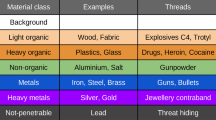Abstract
High-energy dual-energy X-ray digital radiography imaging is mainly used in the material recognition of cargo inspection. We introduce the development history and principle of the technology and describe the data process flow of our system. The system corrects original data to get a dual-energy transparence image. Material categories of all points in the image are identified by the classification curve, which is related to the X-ray energy spectrum. For the calibration of classification curve, our strategy involves a basic curve calibration and a real-time correction devoted to enhancing the classification accuracy. Image segmentation and denoising methods are applied to smooth the image. The image contains more information after colorization. Some results show that our methods achieve the desired effect.






Similar content being viewed by others
References
L. Li, Z.Q. Chen, Y.X. Xing et al., A general exact method for synthesizing parallel-beam projections from cone-beam projections via filtered backprojection. Phys. Med. Biol. 51, 5643–5654 (2006). doi:10.1088/0031-9155/51/21/017
G.W. Zhang, J.P. Cheng, L. Zhang et al., A practical reconstruction method for dual energy computed tomography. J. X-ray Sci. Technol. 16, 67–88 (2008)
L. Li, K.J. Kang, Z.Q. Chen et al., A general region-of-interest image reconstruction approach with truncated Hilbert transform. J. X-ray Sci. Technol. 17, 135–152 (2009). doi:10.3233/XST-2009-0218
M.F. Vorogushin, Experiments on material recognition for 8 MeV customs inspection system for trucks and large-scale container. In Proceeding of the 20th Int’l Linear Accelerator Conference, Monterey, CA, USA (2000)
X.W. Wang, J.M. Li, C.X. Tang et al., Material discrimination by high-energy X-ray dual-energy imaging. High Energy Phys. Nucl. Phys. 31, 1076–1081 (2007)
Z.Q. Chen, T. Zhao, L. Li, The review of high energy dual-energy X-ray DR imaging and material recognition technology. CT Theor. Appl. 23, 731–742 (2014). (in Chinese)
X.W. Wang, Research on the Theory and Experiment of Material Discrimination by Dual-energy Method in High-energy X-ray Imaging. Ph.D. Thesis, Tsinghua University (2005) (in Chinese)
Z.Q. Chen, L. Li, J.C. Feng, New development of high energy industrial computed tomography. CT Theor. Appl. 14, 1–4 (2005). doi:10.3969/j.issn.1004-4140.2005.04.001. (in Chinese)
S. Ogorodnikov, V. Petrunin, Processing of interlaced images in 4–10 MeV dual energy customs system for material recognition. Phys. Rev. Spec. Top-AC 5, 104701 (2002). doi:10.1103/PhysRevSTAB.5.104701
S.A. Ogorodnikov, V.I. Petrunin, M.F. Vorogushin, Application of high-penetrating introscopy systems for recognition of materials. In Proceeding of the 7th European particle accelerator conference, Vienna, Austria (2000)
V.L. Novikov, S.A. Ogorodnikov, V.I. Petrunin, Dual energy method of material recognition in high energy introscopy systems. In Proceeding of the 16th Int’l. Workshop on Charged Particle Linear accelerators, Alushta, Crimea, Ukraine (1999) (in Chinese)
S. Ogorodnikov, V. Petrunin, M. Vorogushin, Radioscopic discrimination of materials in 1/10 MeV range for customs applications. In Proceeding of the 8th European Particle Accelerator Conference, Paris, France (2002)
K. Fu, Performance Enhancement Approaches for a Dual Energy X-ray. Ph.D. Thesis, University of California (2010)
X.P. Wu, Research and Application on Dual Energy X-ray Method of Material Recognition. Ph.D. Thesis, Tsinghua University (2004) (in Chinese)
X.P. Wu, Z.Q. Chen, X.W. Wang, Application of LCIS for material discrimination with dual energy method. Nucl. Electron. Detect. Technol. 25, 782–784 (2005). doi:10.3969/j.issn.0258-0934.2005.06.055. (in Chinese)
Q.H. Li, X.W. Wang, J.M. Li et al., Research on multi-spectrum detector in High-energy dual-energy X-ray imaging system. Nucl. Electron. Detect. Technol. 28, 821–825 (2008). doi:10.3969/j.issn.0258-0934.2008.04.037. (in Chinese)
S.W. Li, K.J. Kang, Y. Wang et al., Employing cerenkov detectors in material effective material atomic number detection of dual-energy X-ray beams. Nucl. Electron. Detect. Technol. 30, 1012–1015 (2010). doi:10.3969/j.issn.0258-0934.2010.08.003. (in Chinese)
Q.H. Li, J.M. Li, X.W. Wang et al., Overlapped objects discrimination using dual-energy, high energy X-ray imaging. J. Tsinghua Univ. Sci. Technol. 48, 1256–1259 (2008). doi:10.3321/j.issn:1000-0054.2008.08.008. (in Chinese)
X.W. Wang, H.Q. Zhong, Q.H. Li et al., The pilot study in the small angle forward scattering used in high energy dual energy imaging method. Prog. Rep. China Nucl. Sci. Technol. 1, 230–235 (2009). (in Chinese)
Acknowledgments
This study was supported by National Natural Science Foundation of China (Nos. 11235007 and 10905030).
Author information
Authors and Affiliations
Corresponding author
Rights and permissions
About this article
Cite this article
Chen, ZQ., Zhao, T. & Li, L. A curve-based material recognition method in MeV dual-energy X-ray imaging system. NUCL SCI TECH 27, 25 (2016). https://doi.org/10.1007/s41365-016-0019-4
Received:
Revised:
Accepted:
Published:
DOI: https://doi.org/10.1007/s41365-016-0019-4




